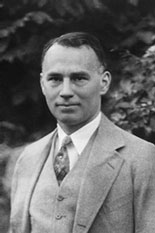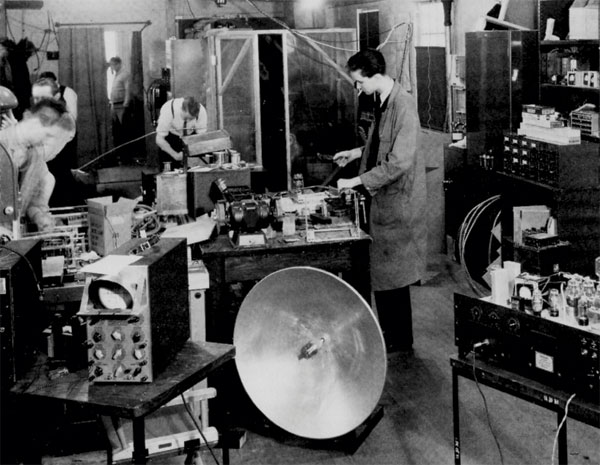
This Article From Issue
November-December 2002
Volume 90, Number 6
DOI: 10.1511/2002.39.0
Tuxedo Park: A Wall Street Tycoon and the Secret Palace of Science that Changed the Course of World War II. Jennet Conant. xviii + 330 pp. Simon and Schuster, 2002. $26.
On the evening of September 29, 1940, a small group of men gathered in the sitting room of a luxurious mansion in the exclusive enclave of Tuxedo Park, New York, some 35 miles northwest of Manhattan. Most were American. But two, John Cockcroft and Edward Bowen, were British physicists who had recently arrived in the United States as part of a top-secret mission to enlist American scientific and technical help in their year-old war against Germany. With some fanfare, they produced a small wooden box, inside of which sat a device called the cavity magnetron, which they promised could generate 1,000 times more power at a wavelength of 10 centimeters than any other microwave transmitter known to U.S. technicians.

From Tuxedo Park.
The event proved a milestone in the war. Within six weeks, more than a year before formally entering the conflict, the United States started the famous MIT Radiation Laboratory to develop microwave radar systems based on the magnetron. The nation's top physicists—10 future Nobel laureates in a lab that employed nearly 4,000 workers by war's end—accepted the challenge. And they succeeded brilliantly, creating radars for the hunting of U-boats, navigation and bombing, fire control, search and early warning, and air-to-air fighter interception. Many of the scientists later went on to work on the atomic bomb, but few afterward doubted which project was more important to the war. As a veteran of both efforts, Hans Bethe once told me: "Surely radar was the most important thing for winning the war . . . . It is a pity that at the end of the war it was overshadowed by the bomb."

From Tuxedo Park
The first half of Conant's book, especially, comes alive as she details Loomis's early years and rise through Yale, Harvard Law School and investment banking—and describes the envy and animosity he and Thorne engendered as their philosophy of quickly liquidating any stocks they held kept them out of the market leading up to the 1929 crash and helped them earn tens of millions in the first years of the Depression. Conant has also nicely put together the story of Loomis's scientific work and his importance in getting the Rad Lab going. She deserves praise as well for dispassionately detailing her subject's colder side—his remoteness from his three boys and the scandalous affair with his best friend's wife, Manette Hobart, which estranged him further from his sons and the society set. (Loomis eventually left his own wife to marry Manette.)
Conant's prose is straightforward and clear—and her strong narrative skills keep the story flowing. Although the book is well researched (sadly, the source notes are scarce, making it difficult to verify certain events and claims), there are more than a few small errors in science, especially concerning radar. For instance, she claims the pulse technique was simultaneously invented in the United States, France, Britain, Germany and Japan. In reality, despite some theoretical work in Germany, it was an American invention, made in 1925 by Merle Tuve of the Carnegie Institution; it was radar, in the mid-1930s, that was essentially coinvented by many of the listed countries (and a few others).
But those errors don't really detract from the story. Of slightly greater concern is the exaggeration of Loomis's roles in the Rad Lab and the Manhattan Project, which form the focus of the book's last few chapters. The overstatements are probably most glaring when it comes to the development of the atomic bomb; there Loomis was a minor figure (barely warranting a mention in Richard Rhodes's classic account, The Making of the Atomic Bomb). But they rankle more in the case of the Rad Lab, which Conant constantly refers to as "Loomis's lab," implying that all its great accomplishments are therefore his doing. Loomis did indeed play a critical part in starting the laboratory, and he chaired the committee, later an NDRC division, to which the Rad Lab reported. But to call the lab his is defensible only on technicalities. He visited only sporadically and had little, if anything, to do with its management. That honor belonged to director Lee DuBridge, later president of Caltech for many years—the Radiation Laboratory was his, if it was anyone's.
Loomis is one of the great behind-the-scenes figures in modern American history. In building him up more than he deserves, however slightly, Conant puts a needless blemish on an otherwise excellent book.
American Scientist Comments and Discussion
To discuss our articles or comment on them, please share them and tag American Scientist on social media platforms. Here are links to our profiles on Twitter, Facebook, and LinkedIn.
If we re-share your post, we will moderate comments/discussion following our comments policy.